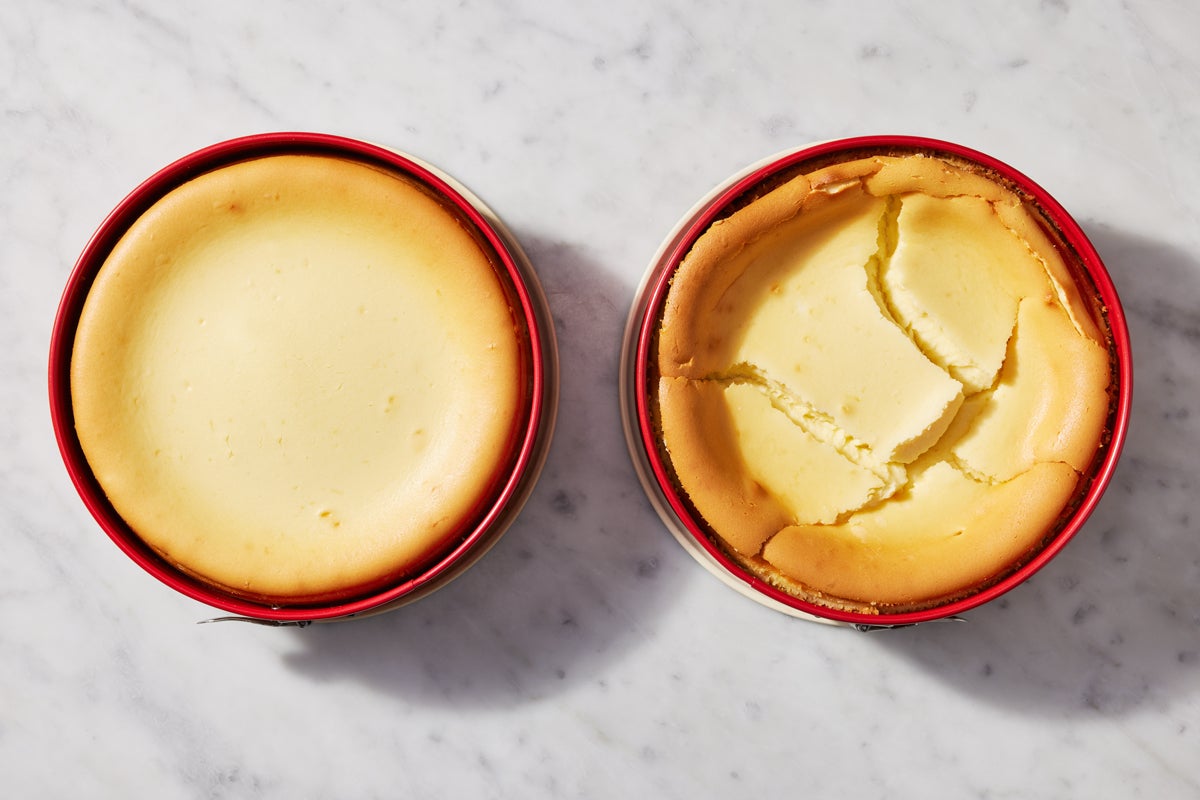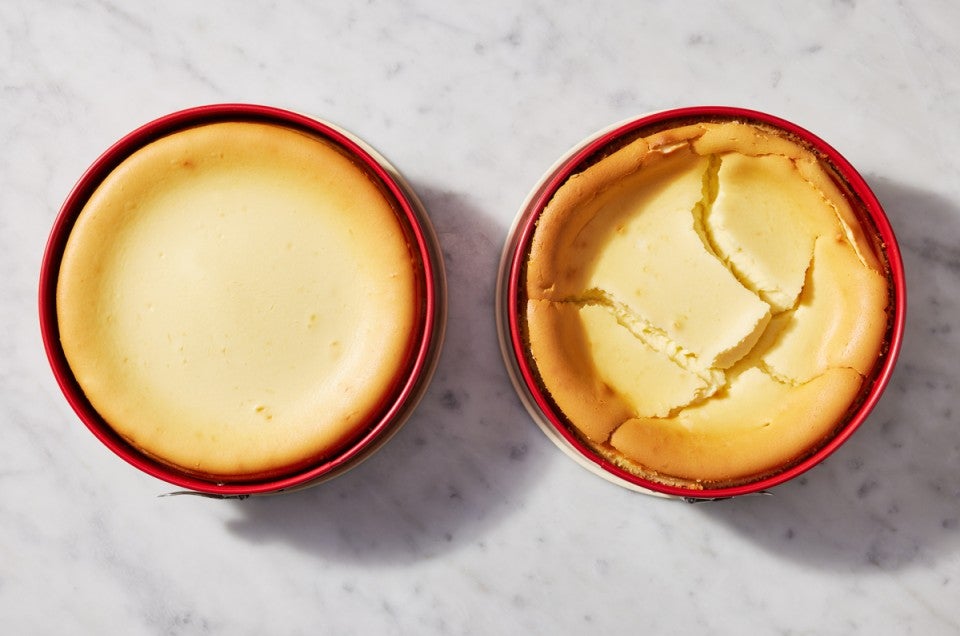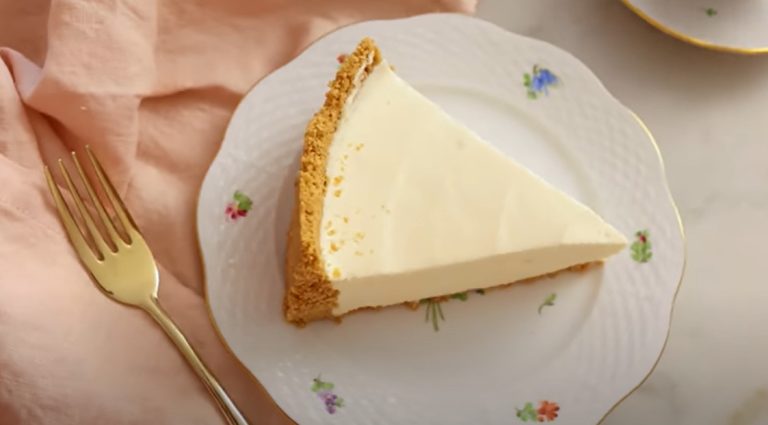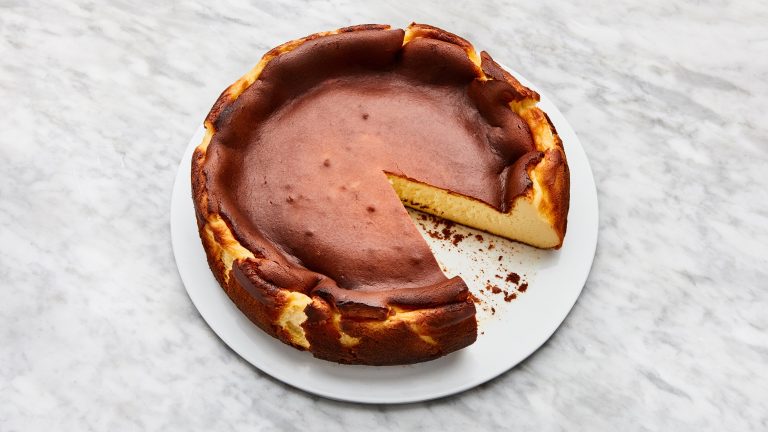How to Keep Cheesecake from Cracking? Expert Tips
There’s nothing quite as disappointing as pulling a homemade cheesecake out of the oven, only to find it marred by cracks. You put in the effort, chose the best ingredients, and yet, the result is less than perfect.
How to keep cheesecake from cracking? To keep cheesecake from cracking, bake it in a water bath, avoid overmixing the batter, and don’t overbake. Let it cool gradually and run a knife around the edges after baking to prevent sticking. Avoid sudden temperature changes to maintain a smooth, crack-free surface.
But don’t worry! You can achieve that smooth, flawless top that makes your cheesecake look like it came straight from a bakery. You’ll discover simple, effective techniques to prevent those pesky cracks. Imagine the satisfaction of slicing into a pristine cheesecake, impressing your guests, and enjoying the perfect blend of creamy texture and delightful taste.
Ready to master the art of cheesecake perfection? Let’s dive in and unlock the secrets to keeping your cheesecake crack-free!
How To Keep Cheesecake From Cracking?
Baking Techniques
Prevent cheesecake cracks by using a water bath during baking. Ensure slow cooling to avoid sudden temperature changes. Keep your batter smooth and avoid overmixing for best results.
Baking a cheesecake can be both an art and a science. Achieving that smooth, creamy texture without a single crack on top is every home baker’s dream. But how can you prevent those pesky cracks from appearing? The secret lies in mastering a few essential baking techniques.
Use A Water Bath
A water bath, or bain-marie, is a tried-and-true technique. By placing your cheesecake pan into a larger pan filled with hot water, you create a humid baking environment. This helps the cheesecake bake evenly and gently, reducing the risk of cracks. Have you ever wondered why restaurants serve flawless cheesecakes? This technique is often the secret.
Avoid Overmixing
Overmixing can be the silent culprit behind cheesecake cracks. When you beat the batter too much, it incorporates excess air. This air expands during baking, and as the cheesecake cools, it contracts, leading to cracks. Instead, mix just until the ingredients are combined. You’d be surprised at how this simple adjustment can make a big difference.
Control The Temperature
Cheesecakes are sensitive to temperature changes. Too high a temperature can cause the top to puff up and crack. Bake your cheesecake at a lower temperature for a longer time. You might need to adjust your schedule slightly, but the result will be worth it.
Gradual Cooling
Avoid the temptation to pull your cheesecake out of the oven and place it directly on the counter. A sudden drop in temperature can cause cracking. Instead, let it cool in the oven with the door slightly ajar. This gradual cooling process is like giving your cheesecake a gentle landing.
Proper Pan Preparation
Lining your pan can make all the difference. Use parchment paper on the bottom and sides for easy release. Plus, it helps ensure even baking. Have you ever struggled with a cheesecake that wouldn’t come out of the pan? This small step can save you from that frustration.
These baking techniques are not just about following steps but understanding why each step matters. Next time you bake a cheesecake, try implementing these strategies. You might just find yourself enjoying a flawless, crack-free dessert. Are you ready to bake your perfect cheesecake?

Credit: www.kingarthurbaking.com
Cooling Methods
Cheesecake is a favorite dessert, known for its creamy texture. Yet, a common problem arises: cracks. The cooling process plays a crucial role in preventing cracks. Proper cooling methods ensure your cheesecake stays smooth and appealing.
Gradual Cooling Process
Allowing the cheesecake to cool gradually is essential. Turn off the oven and leave the cheesecake inside. Let it sit in the oven with the door slightly ajar for about an hour. This gradual cooling helps the cake settle without sudden temperature changes.
Room Temperature Cooling
After the oven cooling, place the cheesecake on a rack. Let it cool at room temperature for another hour. This step prevents condensation, which could lead to soggy texture or cracking.
Refrigerator Cooling
Wrap the cheesecake loosely with plastic wrap. Place it in the refrigerator for at least 4 hours, or overnight. This ensures the cheesecake firms up properly and retains its structure.
Avoid Quick Cooling
Quick cooling methods, like placing the cheesecake directly in the fridge, can cause cracks. Sudden temperature changes lead to uneven cooling and structural stress. Avoid these methods to keep your cheesecake flawless.
Ingredient Adjustments
Cracking is a common issue with cheesecakes. But adjusting the ingredients can help. Ingredient adjustments can enhance texture and prevent cracks.
Adjust The Cream Cheese
Using the right cream cheese matters. Choose full-fat cream cheese for a smoother texture. Avoid low-fat versions as they can cause cracks. Ensure the cream cheese is at room temperature. This helps it blend smoothly with other ingredients.
Use Sour Cream Wisely
Sour cream adds moisture to the cheesecake. It makes the texture creamy and prevents dryness. Use fresh sour cream for the best results. Mix it well to ensure a smooth batter. Sour cream balances the richness of cream cheese.
Perfect The Eggs
Eggs hold the cheesecake together. Be careful not to overbeat them. Overbeating creates air bubbles, leading to cracks. Use room temperature eggs for better blending. The number of eggs affects the density. Balance is key.
Incorporate Cornstarch Or Flour
Cornstarch or flour can stabilize the cheesecake. They help absorb excess moisture. This prevents cracking during baking. Add them sparingly to maintain the creamy texture. Use a gentle hand when mixing.
Proper Sweetener Selection
Sweeteners affect the consistency of the cheesecake. Sugar is the common choice. Ensure it dissolves completely for a smooth batter. Consider powdered sugar for finer texture. Avoid overly sweetened batter to prevent texture issues.

Credit: www.reddit.com
Choosing The Right Pan
Selecting the correct pan is crucial for avoiding cracks in cheesecake. A springform pan allows even baking and smooth removal, reducing the risk of surface cracks. Opt for non-stick options to ensure the cheesecake slides out effortlessly, maintaining its perfect form.
Choosing the right pan for your cheesecake is a crucial step that can make or break your dessert. The pan you select influences the baking process, helping prevent those dreaded cracks. A well-chosen pan provides even heat distribution and prevents the cheesecake from sticking, ensuring a smooth finish.
Understanding Pan Material
Pan material plays a vital role. Non-stick pans are popular, but can they really help your cheesecake? While they make it easy to remove the cake, they might not always offer the best heat distribution. Consider using an aluminum pan, which evenly spreads heat, minimizing the risk of cracks.
Size Matters
Have you ever wondered why your cheesecake cracks despite following the recipe? The answer might lie in the pan size. A pan that’s too small can cause the batter to overflow, leading to cracks. Opt for a 9-inch springform pan for most recipes. It provides ample space for the batter to rise without spilling over.
Springform Pan Advantages
The springform pan is your cheesecake’s best friend. Its detachable sides make it easy to remove the cake without causing damage. You won’t have to worry about flipping the cake upside down, preventing unnecessary stress that can lead to cracks. Have you tried using a springform pan? It’s a game changer for perfect cheesecakes.
Water Bath Techniques
A water bath can keep your cheesecake moist and crack-free. Place your pan inside a larger pan filled with hot water. The steam from the water bath gently cooks the cheesecake, reducing the chance of cracks. It might sound like extra work, but it’s worth the effort for that flawless surface.
Pan Preparation Tips
What’s your pan preparation strategy? Lining the bottom with parchment paper and greasing the sides can make a world of difference. This simple step prevents sticking and allows for smooth removal. Your cheesecake deserves the best care, right from the pan choice to the finishing touches.
Remember, every detail counts when baking a cheesecake. The right pan is your secret weapon in creating a masterpiece that not only tastes divine but looks impeccable. Are you ready to make your cheesecake the star of your next gathering?
Troubleshooting Cracks
Cheesecake often cracks, leaving bakers frustrated. Understanding why cracks form can help. These imperfections usually appear during baking or cooling. But don’t worry, you can fix them. A few simple techniques can make your cheesecake look perfect.
Identifying The Cause
Cracks can occur due to overbaking. The cheesecake dries out and splits. Overmixing is another culprit. It adds too much air to the batter. As the cheesecake cools, the air escapes, causing cracks.
Temperature Control
Keep an eye on oven temperature. Too hot, and the cheesecake will cook unevenly. Use an oven thermometer for accuracy. Also, avoid sudden temperature changes. Let the cheesecake cool slowly.
Water Bath Technique
Bake your cheesecake in a water bath. This method keeps the temperature even. It prevents the edges from cooking too fast. Wrap the pan in foil to keep water out.
Proper Cooling
After baking, let the cheesecake cool in the oven. Open the door slightly to release heat. Then, move it to a wire rack. Cooling gradually reduces the risk of cracks.
Gentle Mixing
Mix ingredients at low speed. This prevents adding too much air. Scrape the bowl often to ensure even mixing. This keeps the texture smooth and prevents cracks.
Fixing Existing Cracks
Some cracks are unavoidable. You can cover them with toppings. Whipped cream or fruit works well. They hide imperfections and add flavor. Your cheesecake will still look delicious.

Credit: www.reddit.com
Frequently Asked Questions
Why Does Cheesecake Crack In The Oven?
Cheesecake cracks due to overbaking or sudden temperature changes. Cooling gradually helps prevent cracks. Keep an eye on the oven.
How Can I Prevent Cheesecake From Cracking?
Use a water bath for even cooking. Avoid overbaking. Cool slowly. These tips minimize cracking and keep it smooth.
Should I Cover Cheesecake While Baking?
Covering traps moisture, reducing cracks. Use foil tenting. Helps keep the surface smooth and creamy.
Conclusion
Keeping your cheesecake crack-free is simple. Start with quality ingredients. Mix them gently. Avoid over-beating. Bake at a low, steady temperature. Use a water bath for even heat. Let it cool gradually. Avoid sudden temperature changes. Always chill before serving.
These steps ensure a smooth, creamy dessert. Practice makes perfect. Try these tips next time. You’ll impress everyone with your flawless cheesecake. Enjoy the delicious, crack-free results. Your patience and care will pay off. Happy baking!
Related Recipes






